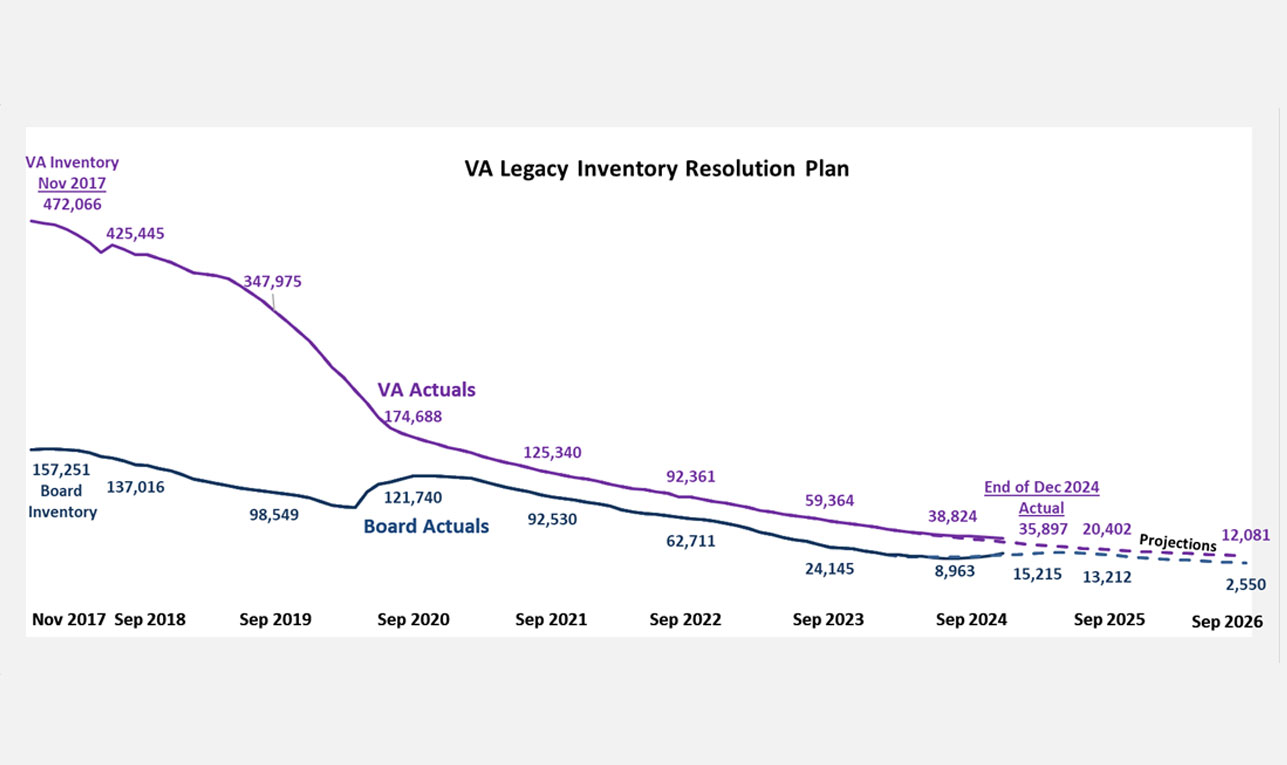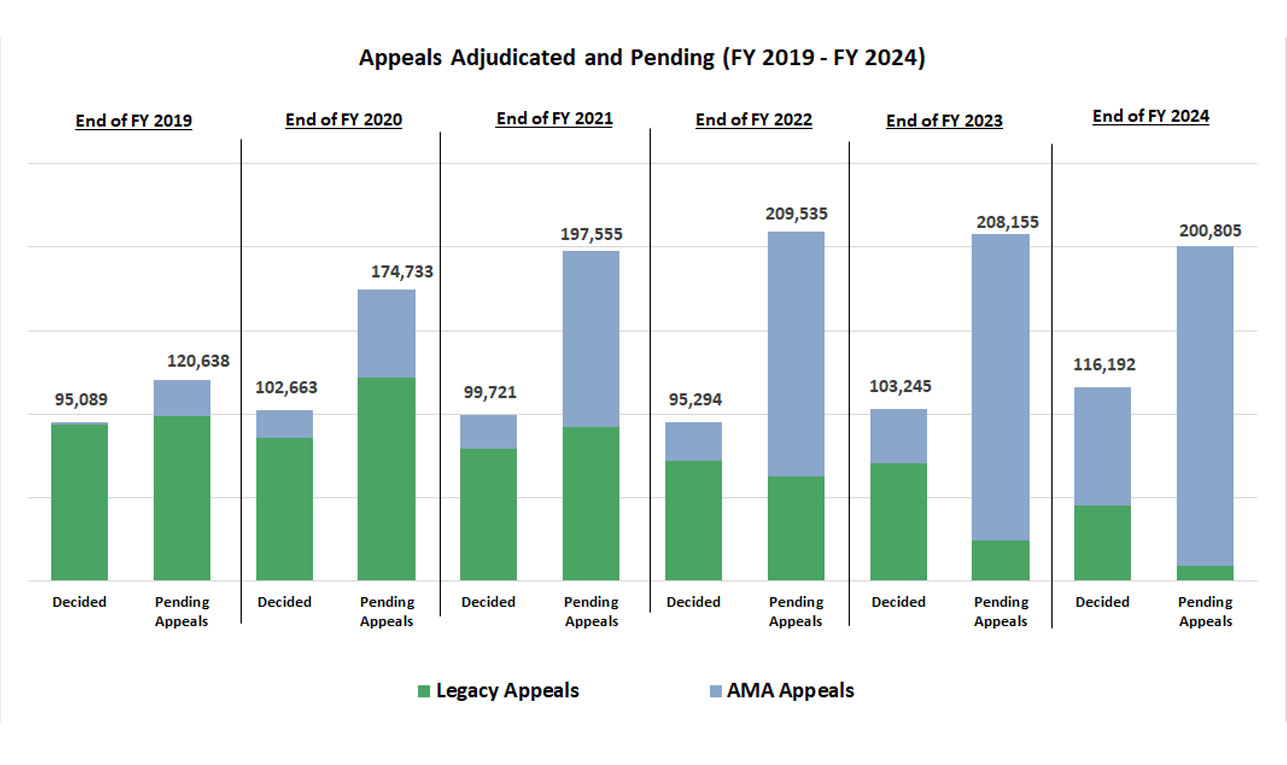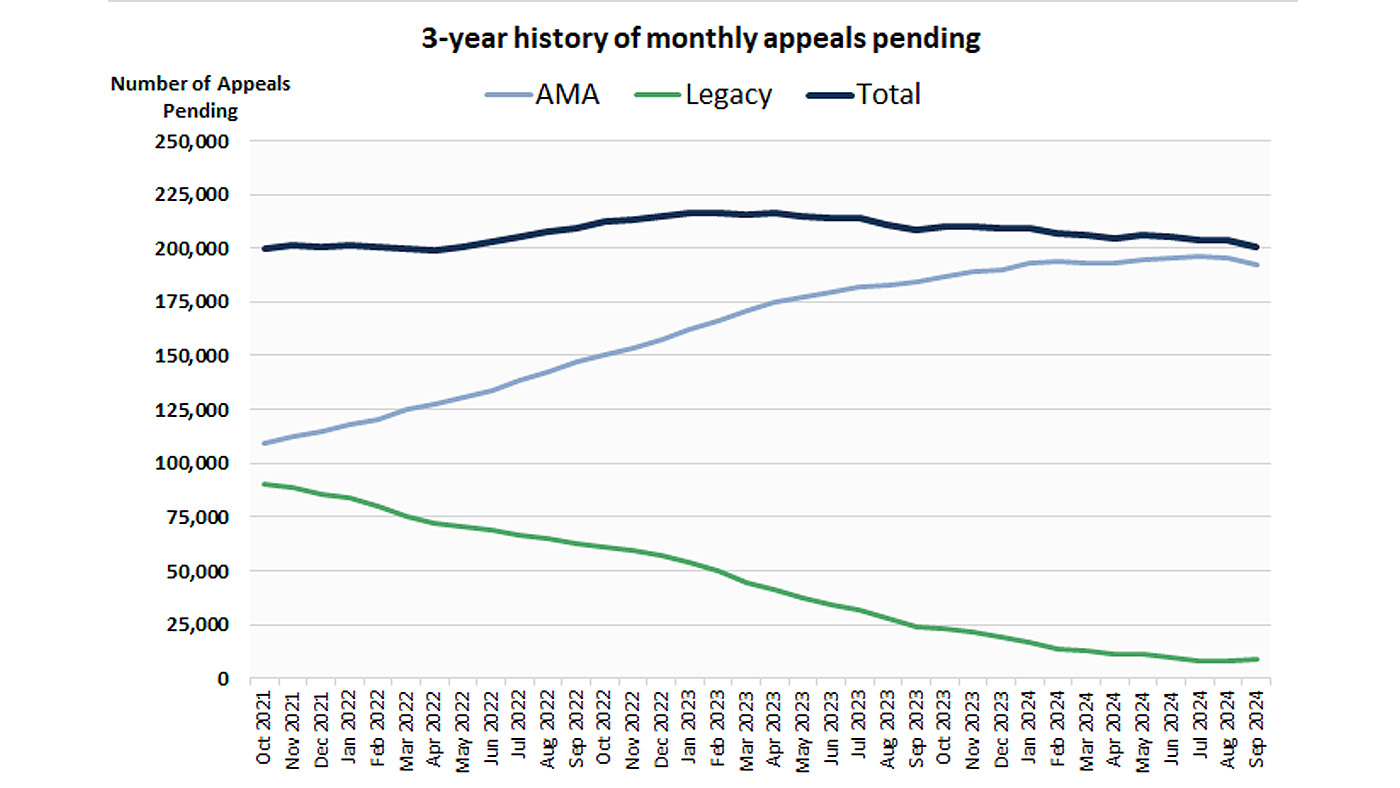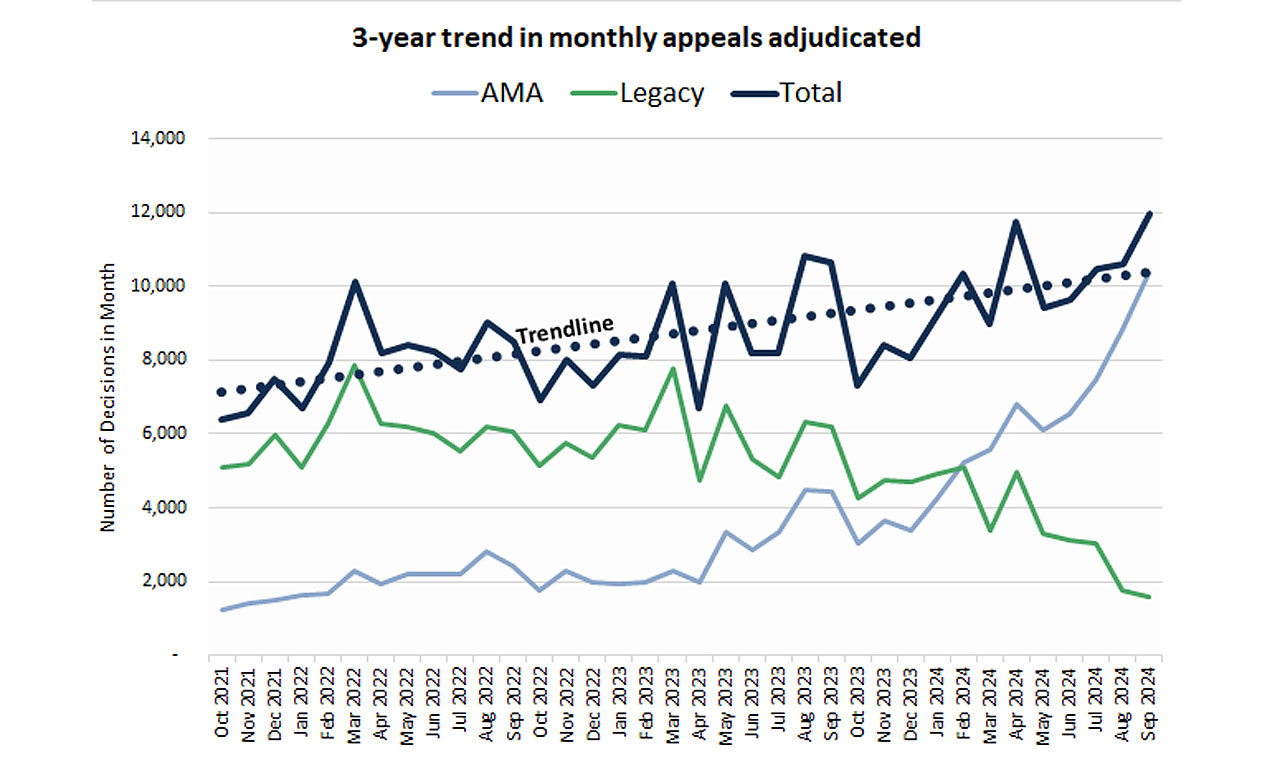Board of Veterans' Appeals
Workload Challenges of Two Separate Appeals Systems
VA understood that the older “Legacy” claims and appeals process was slow and confusing, and, in response, worked with Congress who passed the Veteran Appeals Improvement and Modernization Act of 2017 (AMA), also known as the modernized review system. You can read the full Public Law. This new review system offers Veterans more choice regarding the type of review they select when they disagree with a VA decision denying a benefit. In addition, the law ensures that Veterans and appellants can preserve the earliest effective date possible by continuously pursuing their claim. This means that as long as a Veteran continuously appeals their claim within the allotted time period, the effective date can go back to the first claim, if it is eventually granted. The AMA also allows Veterans and appellants to seek an additional review after a Board decision without going to the United States Court of Appeals for Veterans Claims; instead they can now file a supplemental claim with the Agency of Original jurisdiction for review of new and relevant evidence following a Board decision. For example, if a Board AMA decision denies an appealed issue, then the Veteran has an entire year to add any missing or additional evidence to their file and resubmit a supplemental claim for VA’s reconsideration. If VA then grants the appeal, the effective date can be set to when the Veteran first filed their initial claim on that issue.
In recent years, the Board has resolved about 100,000 appeals each year and the number of decisions issued each year has been steadily rising during each of the past three years. However, the persistent challenge has been how many Legacy system appeals continue to be active more than seven years after the passage of the Appeals Modernization Act of 2017. There were nearly 475,000 Legacy system appeals waiting for a decision seven years ago and the drop over the next few years was substantial. However the reduction in pending Legacy system appeals has slowed considerably due to necessary remands because of ever-changing circumstances in cases. For the past year, 54 percent of all Legacy system cases pending at the Board have been previously adjudicated by the Board at least two times previously, and nearly 10% have been previously adjudicated at least five times. There are still just under 36,000 Legacy appeals not fully resolved by VA:

Legacy Appeal Drawdown Progress.
- VA Legacy Appeal Inventory November, 2017: 472,066. Board Inventory November, 2017: 157,251.
- VA Legacy Inventory September 2018: 425,445.
Board Legacy Inventory September 2018: 137,016. - VA Legacy Inventory September 2019: 347,975.
Board Legacy Inventory September 2019: 98,549. - VA Legacy Inventory September 2020: 174,688.
Board Legacy Inventory September 2020: 121,740. - VA Legacy Inventory September 2021: 125,340.
Board Legacy Inventory September 2021: 92,530. - VA Legacy Inventory September 2022: 92,361.
Board Legacy Inventory September 2022: 62,711. - VA Legacy Inventory September 2023: 59,364.
Board Legacy Inventory October 2023: 24,145. - VA Legacy Inventory September 2024: 38,824.
Board Legacy Inventory September 2024: 8,963. - VA Legacy Inventory December 2024: 35,897.
Board Legacy Inventory December 2024: 15,215. - Projected VA Legacy Inventory End of FY 2025: 20,402.
Projected Board Legacy Inventory End of FY 2025: 13,212. - Projected VA Legacy Inventory End of FY 2026: 12,081.
Projected Board Legacy Inventory End of FY 2026: 2,550.
VA continues to balance this lingering workload of Legacy system cases against the increasing number of Veterans who have filed newer appeals under the AMA during the past five years. This careful balance of trying to keep the promise of resolving older Legacy cases while working newer AMA cases has proven to be incredibly challenging. AMA inventories of pending appeals continued to rise as the Board was forced to re-adjudicate Legacy system cases multiple times until full resolution of all issues in each case.
The good news is that wait times are improving, as the inventory of appeals awaiting a decision at the Board has dropped during each of the last two years because the Board is now able to adjudicate higher numbers of AMA cases. The pending appeals inventory peaked at just over 216,000 appeals in April 2023 and the increases in Board personnel since the end of FY 2022 have brought the inventory down by nearly 10 percent and the number of pending appeals continues to steadily fall during FY 2025. Below is a five-year trend of changes in both pending and decided appeals at the Board:

TITLE GOES HERE
As the Legacy system cases continue to drawdown, the Board is deciding an ever-increasing number of AMA appeals each year. During the first years after AMA implementation, relatively few AMA cases were decided because the Legacy appeals system inventory was still so large. Currently, more than 85% of all decided cases each week are appeals filed under the newer AMA see More Board Personnel Address Pending AMA Appeals and Wait Times and Veterans are getting better results see AMA Appeals System Shows Improvements Over Legacy System.

TITLE GOES HERE
Note: Monthly appeals pending includes appeals from all VA administrations (VBA, VHA, and NCA), a majority of which (greater than 90%) are compensation and pension appeals.
It is important to note that the Veteran-related AMA appeals pending at the Board is much lower than shown above for FY 2024. In August 2024, there was a significant rise in Board appeals pending because a high number of VHA third-party contract provider appeals were moved from the pre-docket queue to the Board’s docket, primarily impacting the AMA Direct Docket and Evidence Submission Docket. While generically labeled as “medical reimbursement” appeals in data reporting systems, the overwhelming majority of these non-rating VHA appeals concern non-Veteran health care providers seeking contract reimbursement from VHA. Currently, there are approximately 20,000 pending AMA appeals from VHA that are not related to Veterans or their dependents seeking relief at the Board. Therefore, the Board is taking care to ensure these non-Veteran 3rd party contract-related VHA appeals in the AMA dockets are appropriately distinguished from other VHA appeals filed by Veterans, dependents, and other beneficiaries.

TITLE GOES HERE
Despite working through the challenges of operating in two appeals system during the transition from an all-Legacy appeals system to a mostly-AMA system, the Board's addition of more judges and counsel led to ever-increasing numbers of decisions issued each month during the past three years: from an average of 7,900 appeals per month in FY 2022, up to almost 9,700 decisions per month during FY 2024.
Below are some links that help explain why the appeal wait times grew and what the Board has been doing to improve.
- Workload Challenges of Two Separate Appeals Systems
- Requirements to Work Cases in Docket Priority Order
- More Board Personnel Address Pending AMA Appeals and Wait Times
- AMA Appeals System Shows Improvements Over Older Legacy System
- Veteran Choices for Type of Board Appeal Influences Wait Times
- Better Decision Quality Leading to Fewer Court Appeals
















